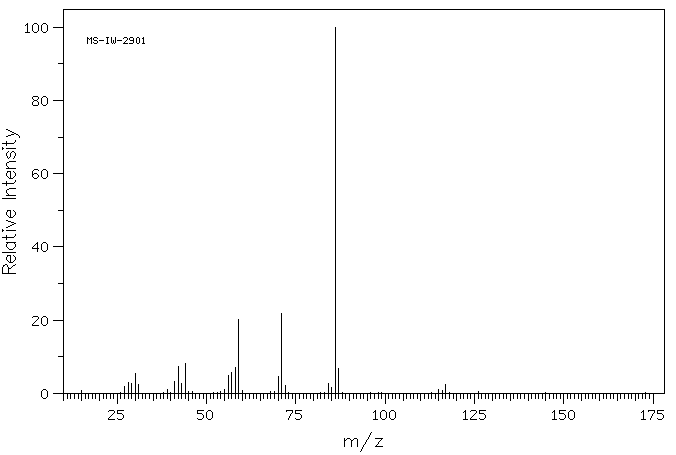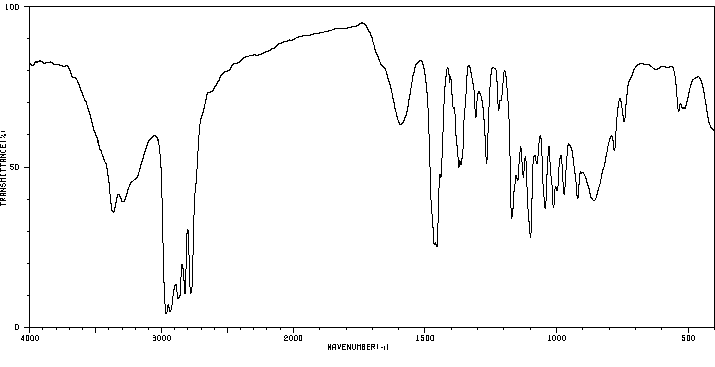N-[1-(氨基甲基)丙基]-N,N-二甲胺 | 19764-59-1
中文名称
N-[1-(氨基甲基)丙基]-N,N-二甲胺
中文别名
N~2~,N~2~-二甲基-1,2-丁烷二胺
英文名称
N2,N2-dimethylbutane-1,2-diamine
英文别名
1-Amino-2-dimethylamino-butan;1-ethyl-N1,N1-dimethyl-ethanediyldiamine;1-Aethyl-N1,N1-dimethyl-aethandiyldiamin;N-[1-(aminomethyl)propyl]-N,N-dimethylamine;2-N,2-N-dimethylbutane-1,2-diamine
CAS
19764-59-1
化学式
C6H16N2
mdl
MFCD09730739
分子量
116.206
InChiKey
QYMUENUCKRLOTB-UHFFFAOYSA-N
BEILSTEIN
——
EINECS
——
-
物化性质
-
计算性质
-
ADMET
-
安全信息
-
SDS
-
制备方法与用途
-
上下游信息
-
文献信息
-
表征谱图
-
同类化合物
-
相关功能分类
-
相关结构分类
物化性质
-
沸点:128.2±8.0 °C(Predicted)
-
密度:0.836±0.06 g/cm3(Predicted)
计算性质
-
辛醇/水分配系数(LogP):0.3
-
重原子数:8
-
可旋转键数:3
-
环数:0.0
-
sp3杂化的碳原子比例:1.0
-
拓扑面积:29.3
-
氢给体数:1
-
氢受体数:2
安全信息
-
危险等级:IRRITANT
-
海关编码:2921290000
SDS
SECTION 1: Identification of the substance/mixture and of the company/undertaking
Product identifiers
Product name : N2,N2-Dimethyl-1,2-Butanediamine
REACH No. : A registration number is not available for this substance as the substance
or its uses are exempted from registration, the annual tonnage does not
require a registration or the registration is envisaged for a later
registration deadline.
Relevant identified uses of the substance or mixture and uses advised against
Identified uses : Laboratory chemicals, Manufacture of substances
SECTION 2: Hazards identification
Classification of the substance or mixture
Classification according to Regulation (EC) No 1272/2008
Acute toxicity, Oral (Category 4), H302
For the full text of the H-Statements mentioned in this Section, see Section 16.
Classification according to EU Directives 67/548/EEC or 1999/45/EC
Xn Harmful R22
For the full text of the R-phrases mentioned in this Section, see Section 16.
Label elements
Labelling according Regulation (EC) No 1272/2008
Pictogram
Signal word Warning
Hazard statement(s)
H302 Harmful if swallowed.
Precautionary statement(s) none
Supplemental Hazard none
Statements
Other hazards
This substance/mixture contains no components considered to be either persistent, bioaccumulative and
toxic (PBT), or very persistent and very bioaccumulative (vPvB) at levels of 0.1% or higher.
SECTION 3: Composition/information on ingredients
Substances
Molecular weight : 116,21 g/mol
Hazardous ingredients according to Regulation (EC) No 1272/2008
Component Classification Concentration
N2,N2-Dimethyl-1,2-Butanediamine
Acute Tox. 4; H302 <= 100 %
Hazardous ingredients according to Directive 1999/45/EC
Component Classification Concentration
N2,N2-Dimethyl-1,2-Butanediamine
Xn, R22 <= 100 %
For the full text of the H-Statements and R-Phrases mentioned in this Section, see Section 16
SECTION 4: First aid measures
Description of first aid measures
General advice
Consult a physician. Show this safety data sheet to the doctor in attendance.
If inhaled
If breathed in, move person into fresh air. If not breathing, give artificial respiration. Consult a physician.
In case of skin contact
Wash off with soap and plenty of water. Consult a physician.
In case of eye contact
Flush eyes with water as a precaution.
If swallowed
Never give anything by mouth to an unconscious person. Rinse mouth with water. Consult a physician.
Most important symptoms and effects, both acute and delayed
The most important known symptoms and effects are described in the labelling (see section 2.2) and/or in
section 11
Indication of any immediate medical attention and special treatment needed
No data available
SECTION 5: Firefighting measures
Extinguishing media
Suitable extinguishing media
Use water spray, alcohol-resistant foam, dry chemical or carbon dioxide.
Special hazards arising from the substance or mixture
Nature of decomposition products not known.
Advice for firefighters
Wear self-contained breathing apparatus for firefighting if necessary.
Further information
No data available
SECTION 6: Accidental release measures
Personal precautions, protective equipment and emergency procedures
Use personal protective equipment. Avoid dust formation. Avoid breathing vapours, mist or gas. Ensure
adequate ventilation. Avoid breathing dust.
For personal protection see section 8.
Environmental precautions
Do not let product enter drains.
Methods and materials for containment and cleaning up
Pick up and arrange disposal without creating dust. Sweep up and shovel. Keep in suitable, closed
containers for disposal.
Reference to other sections
For disposal see section 13.
SECTION 7: Handling and storage
Precautions for safe handling
Avoid contact with skin and eyes. Avoid formation of dust and aerosols.
Provide appropriate exhaust ventilation at places where dust is formed.
For precautions see section 2.2.
Conditions for safe storage, including any incompatibilities
Store in cool place. Keep container tightly closed in a dry and well-ventilated place.
Storage class (TRGS 510): Non Combustible Solids
Specific end use(s)
Apart from the uses mentioned in section 1.2 no other specific uses are stipulated
SECTION 8: Exposure controls/personal protection
Control parameters
Components with workplace control parameters
Exposure controls
Appropriate engineering controls
Handle in accordance with good industrial hygiene and safety practice. Wash hands before breaks and
at the end of workday.
Personal protective equipment
Eye/face protection
Safety glasses with side-shields conforming to EN166 Use equipment for eye protection tested
and approved under appropriate government standards such as NIOSH (US) or EN 166(EU).
Skin protection
Handle with gloves. Gloves must be inspected prior to use. Use proper glove removal technique
(without touching glove's outer surface) to avoid skin contact with this product. Dispose of
contaminated gloves after use in accordance with applicable laws and good laboratory practices.
Wash and dry hands.
The selected protective gloves have to satisfy the specifications of EU Directive 89/686/EEC and
the standard EN 374 derived from it.
Body Protection
Complete suit protecting against chemicals, The type of protective equipment must be selected
according to the concentration and amount of the dangerous substance at the specific workplace.
Respiratory protection
For nuisance exposures use type P95 (US) or type P1 (EU EN 143) particle respirator.For higher
level protection use type OV/AG/P99 (US) or type ABEK-P2 (EU EN 143) respirator cartridges.
Use respirators and components tested and approved under appropriate government standards
such as NIOSH (US) or CEN (EU).
Control of environmental exposure
Do not let product enter drains.
SECTION 9: Physical and chemical properties
Information on basic physical and chemical properties
a) Appearance Form: solid
b) Odour No data available
c) Odour Threshold No data available
d) pH No data available
e) Melting point/freezing No data available
point
f) Initial boiling point and No data available
boiling range
g) Flash point No data available
h) Evaporation rate No data available
i) Flammability (solid, gas) No data available
j) Upper/lower No data available
flammability or
explosive limits
k) Vapour pressure No data available
l) Vapour density No data available
m) Relative density No data available
n) Water solubility No data available
o) Partition coefficient: n- No data available
octanol/water
p) Auto-ignition No data available
temperature
q) Decomposition No data available
temperature
r) Viscosity No data available
s) Explosive properties No data available
t) Oxidizing properties No data available
Other safety information
No data available
SECTION 10: Stability and reactivity
Reactivity
No data available
Chemical stability
Stable under recommended storage conditions.
Possibility of hazardous reactions
No data available
Conditions to avoid
No data available
Incompatible materials
No data available
Hazardous decomposition products
In the event of fire: see section 5
SECTION 11: Toxicological information
Information on toxicological effects
Acute toxicity
No data available
Skin corrosion/irritation
No data available
Serious eye damage/eye irritation
No data available
Respiratory or skin sensitisation
No data available
Germ cell mutagenicity
No data available
Carcinogenicity
IARC: No component of this product present at levels greater than or equal to 0.1% is identified as
probable, possible or confirmed human carcinogen by IARC.
Reproductive toxicity
No data available
Specific target organ toxicity - single exposure
No data available
Specific target organ toxicity - repeated exposure
No data available
Aspiration hazard
No data available
Additional Information
RTECS: Not available
SECTION 12: Ecological information
Toxicity
No data available
Persistence and degradability
No data available
Bioaccumulative potential
No data available
Mobility in soil
No data available
Results of PBT and vPvB assessment
This substance/mixture contains no components considered to be either persistent, bioaccumulative and
toxic (PBT), or very persistent and very bioaccumulative (vPvB) at levels of 0.1% or higher.
Other adverse effects
No data available
SECTION 13: Disposal considerations
Waste treatment methods
Product
Offer surplus and non-recyclable solutions to a licensed disposal company. Dissolve or mix the material
with a combustible solvent and burn in a chemical incinerator equipped with an afterburner and scrubber.
Contaminated packaging
Dispose of as unused product.
SECTION 14: Transport information
UN number
ADR/RID: - IMDG: - IATA: -
UN proper shipping name
ADR/RID: Not dangerous goods
IMDG: Not dangerous goods
IATA: Not dangerous goods
Transport hazard class(es)
ADR/RID: - IMDG: - IATA: -
Packaging group
ADR/RID: - IMDG: - IATA: -
Environmental hazards
ADR/RID: no IMDG Marine pollutant: no IATA: no
Special precautions for user
No data available
SECTION 15: Regulatory information
This safety datasheet complies with the requirements of Regulation (EC) No. 1907/2006.
Safety, health and environmental regulations/legislation specific for the substance or mixture
No data available
Chemical Safety Assessment
For this product a chemical safety assessment was not carried out
SECTION 16: Other information
Full text of H-Statements referred to under sections 2 and 3.
Acute Tox. Acute toxicity
H302 Harmful if swallowed.
Full text of R-phrases referred to under sections 2 and 3
Xn Harmful
R22 Harmful if swallowed.
Further information
Copyright 2014 Co. LLC. License granted to make unlimited paper copies for internal use
only.
The above information is believed to be correct but does not purport to be all inclusive and shall be
used only as a guide. The information in this document is based on the present state of our knowledge
and is applicable to the product with regard to appropriate safety precautions. It does not represent any
guarantee of the properties of the product. Corporation and its Affiliates shall not be held
liable for any damage resulting from handling or from contact with the above product. See
and/or the reverse side of invoice or packing slip for additional terms and conditions of sale.
反应信息
-
作为反应物:描述:参考文献:名称:Kumar; De Paulis; Bengtsson, European Journal of Medicinal Chemistry, 1986, vol. 21, # 1, p. 1 - 3摘要:DOI:
-
作为产物:参考文献:名称:93.还原α-氨基腈摘要:DOI:10.1039/jr9330000347
文献信息
-
[EN] Novel pyrido[2,3-b]indole compounds for the treatment and prophylaxis of bacterial infection<br/>[FR] NOUVEAUX COMPOSÉS PYRIDO[2,3-B]INDOLE POUR LE TRAITEMENT ET LA PROPHYLAXIE D'UNE INFECTION BACTÉRIENNE申请人:HOFFMANN LA ROCHE公开号:WO2018178041A1公开(公告)日:2018-10-04The present invention relates to novel compounds of formula (I), wherein R1, R2, R3, R4, R5 and R6 are as described herein, and their pharmaceutically acceptable salt, enantiomer or diastereomer thereof, and compositions including the compounds and methods of using the compounds.本发明涉及式(I)的新化合物,其中R1、R2、R3、R4、R5和R6如本文所述,以及它们的药用盐、对映体或二对映体,以及包括这些化合物的组合物和使用这些化合物的方法。
-
Discovery of a PCAF Bromodomain Chemical Probe作者:Moses Moustakim、Peter G. K. Clark、Laura Trulli、Angel L. Fuentes de Arriba、Matthias T. Ehebauer、Apirat Chaikuad、Emma J. Murphy、Jacqui Mendez‐Johnson、Danette Daniels、Chun‐Feng D. Hou、Yu‐Hui Lin、John R. Walker、Raymond Hui、Hongbing Yang、Lucy Dorrell、Catherine M. Rogers、Octovia P. Monteiro、Oleg Fedorov、Kilian V. M. Huber、Stefan Knapp、Jag Heer、Darren J. Dixon、Paul E. BrennanDOI:10.1002/anie.201610816日期:2017.1.16bromodomain‐containing lysine acetyl transferases are members of subfamily I of the bromodomain phylogenetic tree. Iterative cycles of rational inhibitor design and biophysical characterization led to the discovery of the triazolopthalazine‐based L‐45 (dubbed L‐Moses) as the first potent, selective, and cell‐active PCAF bromodomain (Brd) inhibitor. Synthesis from readily available (1R,2S)‐(−)‐norephedrine furnishedp300 / CBP相关因子(PCAF)和相关的GCN5含溴结构域的赖氨酸乙酰基转移酶是溴结构域系统发育树的亚家族I的成员。合理的抑制剂设计和生物物理特征的反复循环导致发现了基于三唑并噻嗪的L-45(称为L-Moses)作为第一种有效的,选择性的和具有细胞活性的PCAF溴结构域(Brd)抑制剂。由易于获得的(1R,2S)-(-)-去氧麻黄碱合成的对映纯形式的L-45。L-45显示出扰乱使用nanoBRET测定细胞PCAF-BRD组蛋白H3.3相互作用,和的共晶体结构L-45与来自恶性疟原虫的同源Brd PfGCN5的组合合理化了对PCAF和GCN5溴结构域的高选择性。化合物L-45在外周血单核细胞(PBMC)中没有可观察到的细胞毒性,在人和小鼠肝微粒体中没有良好的细胞渗透性和代谢稳定性,支持其在体内使用的潜力。
-
[EN] THIENOPYRIMIDINES AS MKNK1 AND MKNK2 INHIBITORS<br/>[FR] THIÉNOPYRIMIDINES EN TANT QU'INHIBITEURS DE MKNK1 ET DE MKNK2申请人:BAYER PHARMA AG公开号:WO2015074986A1公开(公告)日:2015-05-28The present invention relates to substituted thienopyrimidine compounds of general formula (I) as described and defined herein, to methods of preparing said compounds, to intermediate compounds useful for preparing said compounds, to pharmaceutical compositions and combinations comprising said compounds and to the use of said compounds for manufacturing a pharmaceutical composition for the treatment or prophylaxis of a disease, in particular of a hyper-proliferative and/or angiogenesis disorder, as a sole agent or in combination with other active ingredients.本发明涉及通式(I)所述的取代噻吩嘧啶化合物,以及制备该化合物的方法,用于制备该化合物的有用中间体化合物,包含该化合物的药物组合物和组合物,以及使用该化合物制造用于治疗或预防疾病的药物组合物,特别是用作唯一药剂或与其他活性成分结合。
-
[EN] PYRIDINE-AND PYRAZINE DERIVATIVES<br/>[FR] DÉRIVÉS DE PYRIDINE ET PYRAZINE申请人:HOELZEMANN GUENTER公开号:WO2012161877A1公开(公告)日:2012-11-29Compounds of the formula (I) in which R, R1 and X have the meanings indicated in Claim 1, are inhibitors of TBK1 and IKKε and can be employed, inter alia, for the treatment of cancer and inflammatory diseases式(I)中R、R1和X具有索引在权利要求书1中的含义的化合物,是TBK1和IKKε的抑制剂,可用于治疗癌症和炎症性疾病。
-
Chk-1 inhibitors申请人:Boyle George Robert公开号:US20050245563A1公开(公告)日:2005-11-03Disclosed are novel inhibitors of Chk-1 and methods of using the same for therapy.本发明涉及一种新的Chk-1抑制剂及其治疗方法。
表征谱图
-
氢谱1HNMR
-
质谱MS
-
碳谱13CNMR
-
红外IR
-
拉曼Raman
-
峰位数据
-
峰位匹配
-
表征信息
同类化合物
(乙腈)二氯镍(II)
(R)-(-)-α-甲基组胺二氢溴化物
(N-(2-甲基丙-2-烯-1-基)乙烷-1,2-二胺)
(4-(苄氧基)-2-(哌啶-1-基)吡啶咪丁-5-基)硼酸
(11-巯基十一烷基)-,,-三甲基溴化铵
鼠立死
鹿花菌素
鲸蜡醇硫酸酯DEA盐
鲸蜡硬脂基二甲基氯化铵
鲸蜡基胺氢氟酸盐
鲸蜡基二甲胺盐酸盐
高苯丙氨醇
高箱鲀毒素
高氯酸5-(二甲氨基)-1-({(E)-[4-(二甲氨基)苯基]甲亚基}氨基)-2-甲基吡啶正离子
高氯酸2-氯-1-({(E)-[4-(二甲氨基)苯基]甲亚基}氨基)-6-甲基吡啶正离子
高氯酸2-(丙烯酰基氧基)-N,N,N-三甲基乙铵
马诺地尔
马来酸氢十八烷酯
马来酸噻吗洛尔EP杂质C
马来酸噻吗洛尔
马来酸倍他司汀
顺式环己烷-1,3-二胺盐酸盐
顺式氯化锆二乙腈
顺式吡咯烷-3,4-二醇盐酸盐
顺式双(3-甲氧基丙腈)二氯铂(II)
顺式3,4-二氟吡咯烷盐酸盐
顺式1-甲基环丙烷1,2-二腈
顺式-二氯-反式-二乙酸-氨-环己胺合铂
顺式-二抗坏血酸(外消旋-1,2-二氨基环己烷)铂(II)水合物
顺式-N,2-二甲基环己胺
顺式-4-甲氧基-环己胺盐酸盐
顺式-4-环己烯-1.2-二胺
顺式-4-氨基-2,2,2-三氟乙酸环己酯
顺式-3-氨基环丁烷甲腈盐酸盐
顺式-2-羟基甲基-1-甲基-1-环己胺
顺式-2-甲基环己胺
顺式-2-(苯基氨基)环己醇
顺式-2-(苯基氨基)环己醇
顺式-2-(氨基甲基)-1-苯基环丙烷羧酸盐酸盐
顺式-1,3-二氨基环戊烷
顺式-1,2-环戊烷二胺二盐酸盐
顺式-1,2-环戊烷二胺
顺式-1,2-环丁腈
顺式-1,2-双氨甲基环己烷
顺式--N,N'-二甲基-1,2-环己二胺
顺式-(R,S)-1,2-二氨基环己烷铂硫酸盐
顺式-(2-氨基-环戊基)-甲醇
顺-2-戊烯腈
顺-1,3-环己烷二胺
顺-1,3-双(氨甲基)环己烷








